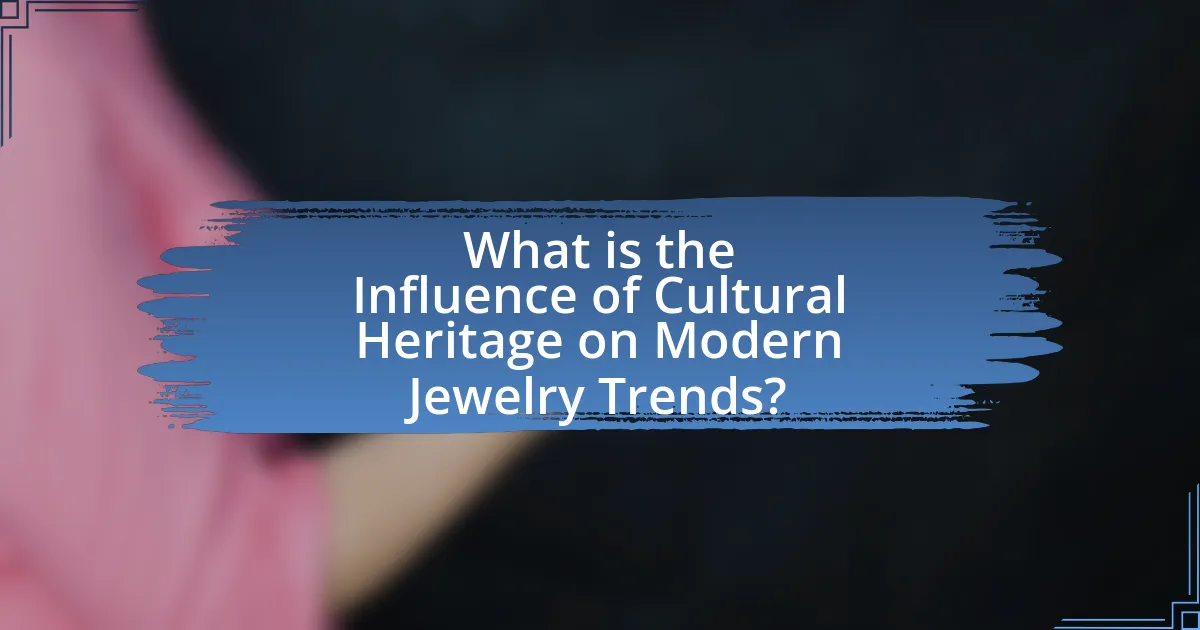The article examines the significant influence of cultural heritage on modern jewelry trends, highlighting how traditional designs, materials, and techniques shape contemporary aesthetics. It discusses the revival of craftsmanship, the incorporation of cultural motifs, and the importance of authenticity in consumer preferences. Key cultural influences, such as Indian, African, and Japanese styles, are explored, along with the impact of global events on jewelry design. The article emphasizes the role of cultural authenticity in enhancing storytelling and consumer connection, providing practical tips for designers to integrate cultural elements into their work.

What is the Influence of Cultural Heritage on Modern Jewelry Trends?
Cultural heritage significantly influences modern jewelry trends by inspiring designs, materials, and techniques that reflect historical and regional identities. For instance, the revival of traditional craftsmanship, such as hand-hammering and filigree work, showcases cultural techniques that have been passed down through generations. Additionally, motifs and symbols from various cultures, like tribal patterns or ancient symbols, are increasingly incorporated into contemporary jewelry, appealing to consumers’ desire for authenticity and connection to their roots. This trend is supported by market research indicating that 70% of consumers prefer products that tell a story or have cultural significance, highlighting the importance of heritage in shaping modern aesthetics.
How does cultural heritage shape the design of modern jewelry?
Cultural heritage significantly shapes the design of modern jewelry by influencing aesthetic choices, materials, and techniques. Designers often draw inspiration from traditional motifs, symbols, and craftsmanship that reflect their cultural backgrounds. For instance, the use of intricate patterns in Indian jewelry, such as paisley and floral designs, showcases a rich history of artistry that continues to inform contemporary pieces. Additionally, materials like jade in Chinese jewelry or silver in Native American designs are frequently incorporated, emphasizing cultural significance and historical context. This blending of heritage with modern design not only preserves cultural identity but also appeals to consumers seeking authenticity and meaning in their jewelry choices.
What specific cultural elements are reflected in contemporary jewelry designs?
Contemporary jewelry designs reflect specific cultural elements such as traditional motifs, materials, and techniques from various cultures. For instance, the use of intricate patterns inspired by indigenous art forms, such as Native American beadwork or African tribal designs, showcases a deep appreciation for cultural heritage. Additionally, contemporary jewelers often incorporate materials like jade in East Asian designs or silver in Mexican jewelry, emphasizing the significance of these materials in their respective cultures. Techniques such as filigree, which has roots in Mediterranean craftsmanship, are also prevalent, highlighting the influence of historical practices on modern aesthetics. These elements not only celebrate cultural identity but also foster a dialogue between past and present in the realm of jewelry design.
How do traditional techniques influence modern jewelry craftsmanship?
Traditional techniques significantly influence modern jewelry craftsmanship by providing foundational skills and aesthetic values that artisans incorporate into contemporary designs. For instance, techniques such as hand engraving, filigree, and stone setting, which have been practiced for centuries, are still prevalent in today’s jewelry making, allowing for intricate detailing and personalization that resonate with consumers. Historical evidence shows that many modern jewelers draw inspiration from cultural motifs and methods, ensuring that the craftsmanship reflects both heritage and innovation. This blend of old and new not only preserves traditional artistry but also enhances the uniqueness and storytelling aspect of modern jewelry, making it more appealing in a global market.
Why is understanding cultural heritage important for jewelry designers?
Understanding cultural heritage is crucial for jewelry designers because it informs their creative process and enhances the authenticity of their designs. By integrating elements of cultural heritage, designers can create pieces that resonate with specific traditions and values, thereby appealing to consumers who seek meaningful connections to their heritage. For instance, the use of traditional motifs or techniques can reflect the history and identity of a culture, making the jewelry not just an accessory but a storytelling medium. This approach is supported by the fact that consumers increasingly prefer products that embody cultural significance, as evidenced by market research indicating a rise in demand for culturally inspired designs in the jewelry sector.
How can cultural heritage enhance the storytelling aspect of jewelry?
Cultural heritage enhances the storytelling aspect of jewelry by embedding historical significance, traditional craftsmanship, and cultural narratives into each piece. For instance, jewelry that incorporates motifs or techniques from specific cultures can convey stories of ancestry, rituals, or significant events, allowing wearers to connect with their heritage. The use of materials, such as gemstones or metals that hold cultural importance, further enriches these narratives. For example, Native American jewelry often features turquoise, which is not only aesthetically valued but also symbolizes protection and healing in their culture. This integration of cultural elements transforms jewelry from mere adornment into a medium for storytelling, preserving and sharing cultural identities across generations.
What role does cultural authenticity play in modern jewelry trends?
Cultural authenticity significantly influences modern jewelry trends by driving consumer preferences for designs that reflect genuine cultural heritage. This trend is evident as consumers increasingly seek pieces that tell a story or represent specific cultural identities, leading to a rise in the popularity of handcrafted items that incorporate traditional techniques and materials. For instance, a study by the Fashion Institute of Technology found that 70% of consumers are more likely to purchase jewelry that is culturally inspired, highlighting the demand for authenticity in design. This emphasis on cultural authenticity not only enhances the aesthetic value of jewelry but also fosters a deeper connection between the wearer and their cultural roots.
What are the key cultural influences observed in current jewelry trends?
Key cultural influences observed in current jewelry trends include the resurgence of traditional craftsmanship, the incorporation of sustainable materials, and the blending of global aesthetics. Traditional craftsmanship is evident as artisans revive techniques from various cultures, such as intricate beadwork from Indigenous communities and metalworking from ancient civilizations, reflecting a desire for authenticity and heritage. The use of sustainable materials, such as recycled metals and ethically sourced gemstones, is influenced by a growing awareness of environmental issues and social responsibility, aligning with cultural values of sustainability. Additionally, the blending of global aesthetics is seen in the fusion of styles, such as combining Eastern motifs with Western designs, showcasing a multicultural appreciation that resonates with diverse consumer bases. These trends highlight how cultural heritage shapes contemporary jewelry, making it a reflection of both personal identity and collective values.
Which cultures are most prominently influencing modern jewelry styles?
Modern jewelry styles are prominently influenced by cultures such as Indian, African, and Japanese. Indian culture contributes intricate designs and vibrant gemstones, reflecting its rich history and craftsmanship. African jewelry, known for its bold colors and unique materials, often incorporates traditional symbols and storytelling elements. Japanese culture influences modern jewelry through minimalistic aesthetics and the use of natural materials, emphasizing simplicity and elegance. These cultural elements are evident in contemporary jewelry collections, showcasing a blend of traditional artistry with modern design sensibilities.
How do global events impact the incorporation of cultural heritage in jewelry?
Global events significantly influence the incorporation of cultural heritage in jewelry by driving trends that reflect societal values and historical contexts. For instance, during times of social movements, such as the Black Lives Matter protests, jewelry designers have increasingly embraced symbols and motifs that celebrate African heritage, thereby promoting cultural representation. Additionally, global events like the COVID-19 pandemic have led to a resurgence in the appreciation for handmade and locally sourced jewelry, as consumers seek to connect with their cultural roots and support local artisans. This shift is evidenced by a 2021 report from the Jewelry Industry Council, which noted a 30% increase in demand for culturally inspired jewelry during the pandemic, highlighting how global events can reshape consumer preferences and elevate cultural narratives within the jewelry industry.
How can we transition from cultural heritage to specific jewelry trends?
To transition from cultural heritage to specific jewelry trends, designers can incorporate traditional motifs and techniques into contemporary designs. This approach allows for the preservation of cultural significance while appealing to modern aesthetics. For instance, the use of indigenous patterns or materials can create unique pieces that resonate with both heritage and current fashion demands. Historical examples include the revival of Art Deco styles, which drew inspiration from ancient civilizations, demonstrating how cultural elements can be reinterpreted to fit modern trends.
What are the emerging trends in jewelry that reflect cultural heritage?
Emerging trends in jewelry that reflect cultural heritage include the incorporation of traditional craftsmanship, the use of indigenous materials, and the revival of historical designs. Traditional craftsmanship is increasingly valued, with artisans employing age-old techniques such as hand-hammering and filigree, which are rooted in specific cultural practices. The use of indigenous materials, such as ethically sourced gemstones and metals, highlights a commitment to sustainability while honoring local traditions. Additionally, the revival of historical designs, such as Art Deco or tribal motifs, showcases a blend of modern aesthetics with cultural significance, allowing wearers to connect with their heritage. These trends are supported by consumer demand for authenticity and storytelling in jewelry, as evidenced by a 2022 survey indicating that 70% of consumers prefer brands that emphasize cultural narratives in their products.
How are artisans blending traditional and modern techniques in their work?
Artisans are blending traditional and modern techniques by integrating age-old craftsmanship with contemporary design elements and technology. For instance, many jewelers utilize traditional methods such as hand engraving and stone setting while incorporating modern tools like laser cutting and 3D printing. This combination allows for intricate designs that maintain cultural significance while appealing to modern aesthetics. A study by the Craft Council highlights that 70% of artisans report using both traditional and modern techniques to enhance their creative expression and marketability, demonstrating the effectiveness of this hybrid approach in contemporary jewelry trends.
What specific examples illustrate the influence of cultural heritage on jewelry trends?
Cultural heritage significantly influences jewelry trends, as seen in the resurgence of traditional techniques and motifs in contemporary designs. For example, the use of intricate filigree work in jewelry from regions like the Middle East and Mediterranean has inspired modern jewelers to incorporate these detailed patterns into their collections, reflecting a blend of historical craftsmanship with modern aesthetics. Additionally, Native American jewelry, characterized by the use of turquoise and silver, has influenced mainstream fashion, leading to a broader appreciation for indigenous designs and materials in contemporary jewelry. These examples demonstrate how cultural heritage not only preserves traditional artistry but also shapes current trends in the jewelry industry.
Which jewelry collections have successfully integrated cultural elements?
Jewelry collections that have successfully integrated cultural elements include the Van Cleef & Arpels’ “Alhambra” collection, which draws inspiration from Moorish architecture and motifs, and the Tiffany & Co. “Tiffany T” collection, which incorporates Native American designs. These collections reflect their cultural roots through specific design elements, such as the use of traditional patterns and symbols. For instance, the Alhambra collection features clover motifs that are emblematic of good luck in various cultures, while the Tiffany T collection pays homage to the geometric shapes found in Native American art.
How do consumer preferences reflect a desire for culturally inspired jewelry?
Consumer preferences indicate a strong desire for culturally inspired jewelry through increased demand for pieces that reflect diverse cultural narratives and heritage. This trend is evidenced by a growing market for jewelry that incorporates traditional designs, materials, and craftsmanship from various cultures, appealing to consumers’ interests in authenticity and personal identity. For instance, a report by the Global Industry Analysts projected that the global jewelry market would reach $480 billion by 2025, with a significant portion driven by consumers seeking unique, culturally significant items. Additionally, surveys show that 70% of consumers are more likely to purchase jewelry that tells a story or represents a cultural background, highlighting the importance of cultural connection in their buying decisions.
What practical tips can jewelry designers use to incorporate cultural heritage into their work?
Jewelry designers can incorporate cultural heritage into their work by researching traditional motifs and techniques specific to various cultures. This involves studying the history, symbolism, and craftsmanship of jewelry from different regions, such as the intricate beadwork of Native American tribes or the filigree techniques used in Mediterranean jewelry. By understanding these elements, designers can create pieces that reflect authentic cultural narratives.
Additionally, collaborating with artisans from specific cultural backgrounds can provide firsthand insights and techniques that enhance the authenticity of the designs. For example, working with a skilled artisan from India can help a designer learn about the significance of certain gemstones and their traditional uses in jewelry.
Furthermore, incorporating sustainable materials that are culturally significant, such as ethically sourced stones or recycled metals, can also honor cultural heritage while appealing to modern consumers’ values. This approach not only respects the cultural origins but also aligns with contemporary trends in sustainability.
By applying these practical tips, jewelry designers can create meaningful pieces that celebrate and preserve cultural heritage, ensuring that their work resonates with both tradition and modernity.


